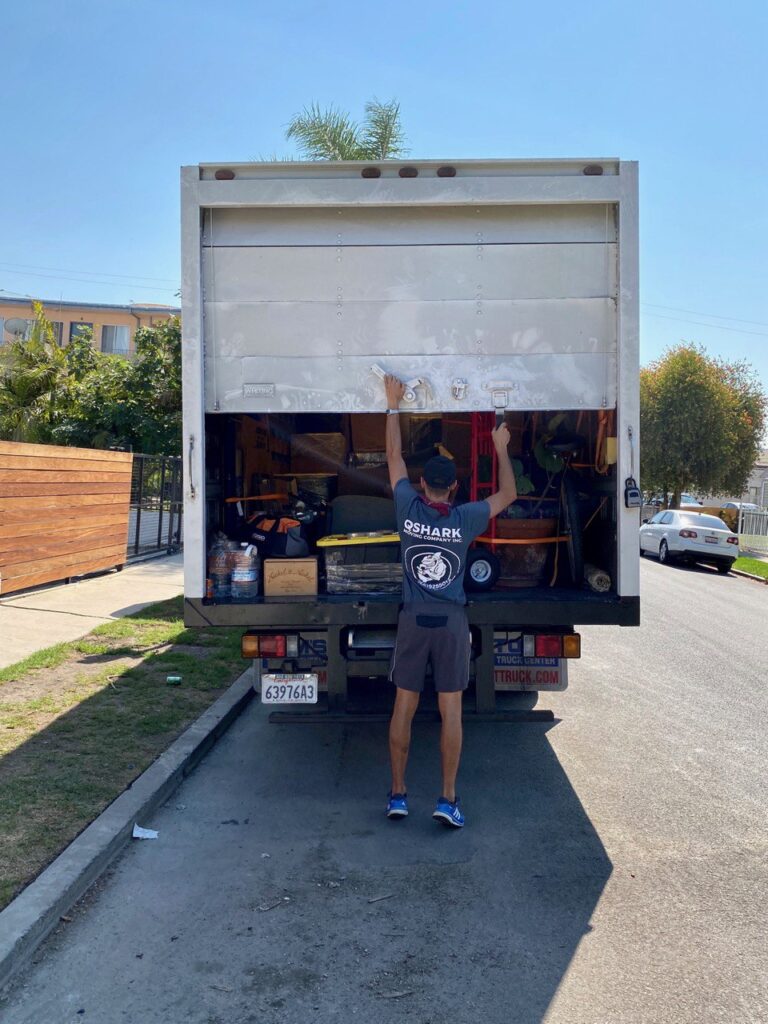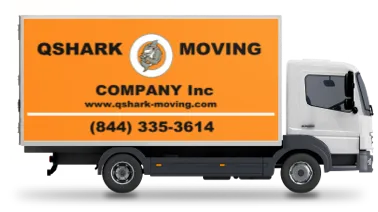
What Do Movers Use To Protect Floors?
At QShark Moving Company, we pride ourselves as one of the top movers who understand that every aspect of your move matters. Among the many elements we pay attention to, floor protection is one that stands out significantly. Your floors, be they hardwood, carpeted, or even marble, are investments in your home or office that we take very seriously. This guide dives deep into how we ensure these valuable aspects of your property are safeguarded throughout your move and what do movers use to protect floors.
Whether you are utilizing our local moving service or you are a long distance mover, we ensure the same level of care and attention is given to your floors. Also, our commitment to floor protection remains unwavering if you’re seeking office moving solutions or even unique services such as piano moving.
Let’s delve into the importance of floor protection during moving:
- Preventing Damages: Floors can easily be scratched, scraped or suffer heavy impact damage during a move. Repairing or replacing flooring can be expensive and time-consuming.
- Maintaining Cleanliness: Dirt and dust from the moving process can make your new home or office unclean before you even settle in.
In the subsequent sections, we’ll discuss in detail the potential dangers to your floors during a move and the steps we, as your professional movers, take to prevent such issues. You will gain an understanding of how we use specialized tools and equipment to protect different types of floors, our step-by-step process of ensuring floor safety, and how our in-house training guarantees all this is possible.
II. The Dangers to Floors During a Move
This section aims to shed light on the potential dangers your floors may face during a move. Being informed about these risks will help you understand the importance of choosing a moving company that highly emphasizes floor protection.
A. Scratches and Scrapes
Moving large pieces of furniture often results in scratches and scrapes on your floors. This is particularly common with hardwood and laminate floors that are vulnerable to such damages. Here’s how it happens:
- Dragging furniture items: Despite being a common practice, dragging furniture poses a risk to your floor. Even with careful handling, furniture’s weight and irregular edges can cause significant scratches or gouges.
- Dropping heavy items: Accidentally dropping a heavy item can result in dents and scratches on the floor.
B. Dirt and Dust
The process of moving can stir up dirt and dust that can then be tracked onto your floors. This is more than just a cleaning concern:
- Dust and grit: These can scratch and dull the finish of your floors. If you have a wooden floor, dust particles can settle into crevices and be difficult to remove.
- Mud and moisture: If it’s a wet day or the move involves traversing outdoor areas, mud or moisture will be brought in, potentially damaging your floors and carpets.
C. Heavy Impact Damage
The weight of large furniture or appliances can sometimes cause indentations or even cracks in certain types of floors.
- Pointed pressure: Some furniture pieces have pointed legs or edges that can exert pressure on a small area of your floor, causing dents or cracks.
- Dropped items: As mentioned earlier, dropped items can not only cause scratches but also result in more serious structural damage to the floor if the dropped item is particularly heavy.
Case Study: One of our customers, moving a large marble dining table without professional help, ended up with a noticeable scratch across their new hardwood floor. This resulted in extra cost and hassle of floor repair, proving that floor protection during moving is not just optional but essential.
Now that we’ve outlined the risks, let’s discuss the different floor types and their specific vulnerabilities.
III. Understanding Different Floor Types and Their Vulnerabilities
Each type of floor has its unique properties and, thus, different susceptibilities to damage. Here, we will elaborate on the most common floor types and what precautions should be taken to protect them.
A. Hardwood Floors
Elegant and timeless, hardwood floors are prone to scratches, dents, and water damage. Special care should be taken to:
- Avoid dragging furniture across the floor. Use appropriate moving equipment like furniture sliders.
- Keep the floor clean and free from sand or grit, which can act like sandpaper under foot traffic or moving objects.
- Use protective coverings like adhesive film or floor runners to shield the floor during the move.
B. Tile and Marble Floors
These floors are durable but can be chipped or cracked under pressure. Protection tips include:
- Avoid dropping heavy objects on the floor as they can cause serious damage.
- Use furniture sliders or dollies to move heavy objects.
- Cover the floors with plywood sheets or floor runners for extra protection during the move.
C. Carpeted Floors
Carpeted floors are susceptible to tears, stains, and dirt. They need the following precautions:
- Make sure to clean the carpet before the move to avoid grinding dirt in during the moving process.
- Use carpet shields or floor runners for added protection against stains and damage.
- Use furniture sliders when moving heavy objects to avoid tears.
D. Laminated and Vinyl Floors
These floors are scratch and dent resistant but can be susceptible to water damage and tearing. To protect them:
- Use floor runners or adhesive films for protection against dirt and spills.
- Always lift and carry furniture instead of dragging it across the floor.
- Keep the floors clean and dry during the move.
E. Concrete Floors
Although sturdy and resilient, concrete floors can still be damaged. Tips for protection include:
- Clean the floor before the move to avoid scratching from dirt or grit.
- Use furniture pads or moving blankets under heavy items to prevent chipping or cracking.
- Even though less likely to get damaged, consider using protective coverings to avoid any possible damage.
Understanding these vulnerabilities helps us at QShark Moving Company to provide you with the best possible moving service. This knowledge allows us to use the appropriate tools and techniques to protect your specific type of floor during the move. We’ll discuss these tools in detail in the following section.

IV. Tools and Equipment QShark Uses to Protect Floors
We at QShark use a variety of tools to ensure your floors stay safe and undamaged during the move. Let’s dive into each of these tools and how they’re used for different types of floors.
1. Furniture Pads and Moving Blankets
Furniture pads and moving blankets are versatile tools we use to protect your furniture and floors.
- They can be placed under furniture to prevent scratches and scrapes on hardwood and laminate floors.
- They are also used to wrap around furniture pieces to prevent damage from bumps and knocks during the move.
2. Floor Runners and Carpet Shields
These are protective coverings that are laid out on the floor to provide a safe path for moving.
- Floor runners are typically made of neoprene or other non-slip materials, and they protect against scratches, scuffs, and spills. They’re ideal for hardwood, laminate, tile, and marble floors.
- Carpet shields are adhesive plastic films that provide a dirt and water-resistant layer over your carpets.
3. Shoe Covers or Booties
Our moving team wears shoe covers or booties to prevent tracking dirt or moisture onto your floors.
- They’re especially important if the moving day is wet or muddy.
- They also prevent scuffs and scratches on hardwood and laminate floors.
4. Furniture Sliders and Dollies
These tools allow us to move heavy items without causing damage to your floors.
- Furniture sliders are placed under the legs of furniture, reducing friction and making it easy to slide heavy items across the floor without scratching or scraping.
- Dollies are used to lift and roll heavy items, reducing the chance of drops or accidents that could damage your floors.
5. Plywood Sheets
We lay down plywood sheets for extremely heavy items to distribute the weight more evenly and prevent cracks or dents.
- They’re especially useful on tile and marble floors which can be chipped or cracked by heavy pressure.
6. Moving Mats
Moving mats are padded coverings that provide extra protection for your floors.
- They’re particularly useful for protecting against heavy impact damage on all types of floors.
Utilizing these tools and equipment effectively ensures your floors are well-protected during the move. However, the tools alone aren’t enough; how we use them makes a difference. The next section’ll describe the step-by-step process to ensure maximum floor protection during your move.

V. Step-by-Step Process of Floor Protection During a Move
Here, we will describe the meticulous process that QShark follows to ensure optimal floor protection during your move. We’re committed to safeguarding your property, and this step-by-step guide illustrates exactly how we do that.
A. Pre-Move Inspection and Floor Type Assessment
First, we start with a pre-move inspection. This includes:
- Identifying the type of flooring in your home or office.
- Determining the appropriate tools and equipment needed for your specific floor type.
- Creating a moving strategy tailored to the layout of your premises and the nature of the items to be moved.
B. Preparing and Cleaning the Floors Before the Move
Next, we prepare the floors for the move. This involves:
- Cleaning the floors to remove any dust or debris that could cause scratches or other damage.
- Assessing any pre-existing damage or areas of concern. This is crucial for post-move evaluation.
C. Laying Out Floor Protection Materials
Once the floors are clean and ready, we begin laying out our floor protection materials. Here’s how we use each tool depending on the floor type:
- We use furniture pads, moving blankets, and floor runners for hardwood and laminate floors to protect against scratches and scuffs.
- We use plywood sheets and dollies for tile and marble floors to prevent cracks or chips.
- We lay down carpet shields for carpeted floors to prevent stains and tears.
- We use moving mats for extra protection against heavy impact damage for all types of floors.
D. Moving Furniture with Care to Avoid Damage
We handle your furniture and other items with care to prevent any potential damage to your floors:
- We use furniture sliders and dollies to move heavy items without dragging them across the floor.
- We ensure that all heavy items are lifted and carried, not dragged, wherever possible.
E. Cleaning and Restoring the Floor Post-Move
Finally, after the move is complete, we clean and restore your floors:
- We remove all protective coverings and clean the floors to ensure they are spotless as before the move.
- We conduct a final inspection to ensure that there has been no damage during the move.
Following this step-by-step process, we at QShark ensure that your floors are thoroughly protected during your move. But the process and tools alone are insufficient; our team’s skills and expertise make the difference. The next section’ll discuss how our team is trained to carry out safe and efficient moves.
VI. In-House Training: The QShark Difference
Our team’s expertise is our most valuable tool when it comes to protecting your floors during a move. Here’s how we ensure that our team members are the best at what they do:
A. Comprehensive Training Program
All QShark team members go through a comprehensive training program where they learn the specifics of floor protection during moving. The program covers:
- Different types of floors and their vulnerabilities.
- The tools and equipment used to protect floors.
- The step-by-step process of ensuring floor protection during a move.
B. Ongoing Learning and Improvement
Our commitment to excellence doesn’t stop at the initial training. We provide ongoing learning opportunities for our team members to stay updated with the latest best practices in the industry. This ensures they are always ready to provide the best service to our clients.
C. Emphasis on Care and Attention to Detail
We emphasize the importance of care and attention to detail in our service. Our team members are trained to treat each item they move with care and pay close attention to protecting your floors.
D. Safety First
Safety is our top priority. Our team members are trained to prioritize safety – for themselves, for your items, and for your floors. They understand that a safe move is a successful move.
Investing in our team’s training and development ensures that our service quality remains high and our customers’ properties are well-protected. The result is a seamless and stress-free moving experience for our customers.
VII. Conclusion. What Do movers use to protect floors?
At QShark Moving Company, we believe in providing a moving service that is efficient, reliable, and mindful of your property. Our commitment to floor protection is just one way we uphold this belief. With our comprehensive process, the right tools and equipment, and our highly trained team, we ensure that your floors are protected during your move. No matter the type of move – be it local, office, or long distance – you can trust QShark to safeguard your property every step of the way. So, the next time you’re planning a move, choose QShark – where we treat your floors like our own.
VIII. Frequently Asked Questions
To wrap up this guide, we’ve addressed frequently asked questions that provide further insight into floor protection during a move.
Q1: How much does adding floor protection to my move cost to add floor protection?
A: At QShark, we believe floor protection is essential to a successful move. Therefore, we incorporate it as a standard part of our moving service without additional costs.
Q2: I’m moving a piano. What additional precautions will you take to protect my floors?
A: Moving a piano requires additional care due to its weight and size. Our piano movers will use moving blankets, furniture sliders, and dollies to ensure the piano and your floors are adequately protected.
Q3: What can I do to prepare my floors for moving day?
A: One of the best things you can do is to ensure your floors are clean before the move. This can prevent scratches caused by dust and debris. You could also remove any obstacles that might interfere with the move, such as rugs or decorative items.
Q4: Can you help with packing to ensure items are safe during the move?
A: Yes, QShark offers comprehensive packing services to ensure all your items are well-protected during the move. Our professional team uses high-quality packing materials and employs careful packing techniques to ensure your belongings arrive safely at your new destination.
Q5: Do you offer services for both residential and commercial moves?
A: Yes, QShark offers services for both residential and commercial moves. Whether you are relocating your home or moving your business, our Orange County movers, Movers in San Diego, and Irvine movers are ready to assist you with your specific needs.
Remember, selecting the right moving company is the most important part of any move.


